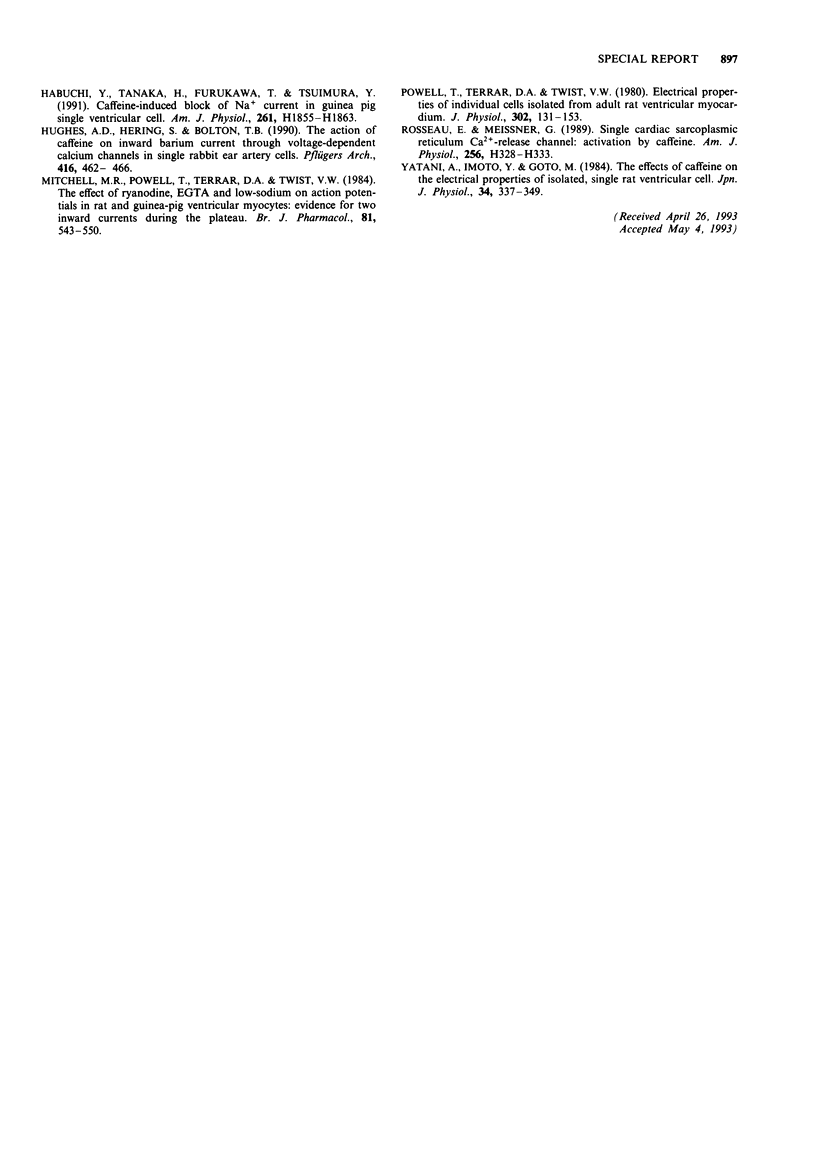Abstract
The effects of high (20 mM) concentrations of caffeine were studied on the transmembrane voltage and currents in rat single ventricular myocytes by the whole cell configuration of the patch clamp technique. Rapid application of caffeine released Ca2+ from the sarcoplasmic reticulum and induced a Ni(2+)-sensitive transient inward current with concomitant change of the transmembrane voltage from -72.6 +/- 0.4 to -68.0 +/- 0.6 mV (n = 4). Maintained application of caffeine lengthened the action potential duration (APD90) from 66.7 +/- 16.9 to 135.1 +/- 34.1 ms (n = 4) and depressed the amplitude of both the inward rectifier potassium and the inward calcium currents. It is concluded that these effects of caffeine should be recognized when it is used as a tool to study electromechanical coupling.
Full text
PDF


Selected References
These references are in PubMed. This may not be the complete list of references from this article.
- Apkon M., Nerbonne J. M. Characterization of two distinct depolarization-activated K+ currents in isolated adult rat ventricular myocytes. J Gen Physiol. 1991 May;97(5):973–1011. doi: 10.1085/jgp.97.5.973. [DOI] [PMC free article] [PubMed] [Google Scholar]
- Beavo J. A., Rogers N. L., Crofford O. B., Hardman J. G., Sutherland E. W., Newman E. V. Effects of xanthine derivatives on lipolysis and on adenosine 3',5'-monophosphate phosphodiesterase activity. Mol Pharmacol. 1970 Nov;6(6):597–603. [PubMed] [Google Scholar]
- Clusin W. T. Caffeine induces a transient inward current in cultured cardiac cells. Nature. 1983 Jan 20;301(5897):248–250. doi: 10.1038/301248a0. [DOI] [PubMed] [Google Scholar]
- Eisner D. A., Lederer W. J., Noble D. Caffeine and tetracaine abolish the slow inward calcium current in sheep cardiac Purkinje fibres [proceedings]. J Physiol. 1979 Aug;293:76P–77P. [PubMed] [Google Scholar]
- Goto M., Yatani A., Ehara T. Interaction between caffeine and adenosine on the membrane current and tension component in the bullfrog atrial muscle. Jpn J Physiol. 1979;29(4):393–409. doi: 10.2170/jjphysiol.29.393. [DOI] [PubMed] [Google Scholar]
- Habuchi Y., Tanaka H., Furukawa T., Tsujimura Y. Caffeine-induced block of Na+ current in guinea pig single ventricular cells. Am J Physiol. 1991 Dec;261(6 Pt 2):H1855–H1863. doi: 10.1152/ajpheart.1991.261.6.H1855. [DOI] [PubMed] [Google Scholar]
- Hughes A. D., Hering S., Bolton T. B. The action of caffeine on inward barium current through voltage-dependent calcium channels in single rabbit ear artery cells. Pflugers Arch. 1990 Jun;416(4):462–466. doi: 10.1007/BF00370755. [DOI] [PubMed] [Google Scholar]
- Mitchell M. R., Powell T., Terrar D. A., Twist V. W. The effects of ryanodine, EGTA and low-sodium on action potentials in rat and guinea-pig ventricular myocytes: evidence for two inward currents during the plateau. Br J Pharmacol. 1984 Mar;81(3):543–550. doi: 10.1111/j.1476-5381.1984.tb10107.x. [DOI] [PMC free article] [PubMed] [Google Scholar]
- Powell T., Terrar D. A., Twist V. W. Electrical properties of individual cells isolated from adult rat ventricular myocardium. J Physiol. 1980 May;302:131–153. doi: 10.1113/jphysiol.1980.sp013234. [DOI] [PMC free article] [PubMed] [Google Scholar]
- Rousseau E., Meissner G. Single cardiac sarcoplasmic reticulum Ca2+-release channel: activation by caffeine. Am J Physiol. 1989 Feb;256(2 Pt 2):H328–H333. doi: 10.1152/ajpheart.1989.256.2.H328. [DOI] [PubMed] [Google Scholar]
- Yatani A., Imoto Y., Goto M. The effects of caffeine on the electrical properties of isolated, single rat ventricular cells. Jpn J Physiol. 1984;34(2):337–349. doi: 10.2170/jjphysiol.34.337. [DOI] [PubMed] [Google Scholar]


